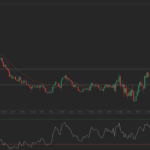 Friday’s trade saw USD/CAD within the range of 1.3313-1.3417. The pair closed at 1.3362, inching up 0.04% on a daily basis and extending the gain from Thursday. The daily high has been the highest level since November 23rd, when a high of 1.3437 was registered. In weekly terms, USD/CAD dipped 0.07% last week, marking its first loss in the past five weeks. The pair has advanced 0.46% so far during the current month.
Friday’s trade saw USD/CAD within the range of 1.3313-1.3417. The pair closed at 1.3362, inching up 0.04% on a daily basis and extending the gain from Thursday. The daily high has been the highest level since November 23rd, when a high of 1.3437 was registered. In weekly terms, USD/CAD dipped 0.07% last week, marking its first loss in the past five weeks. The pair has advanced 0.46% so far during the current month.
At 10:09 GMT today USD/CAD was gaining 0.47% for the day to trade at 1.3426. The pair overcame the upper range breakout level (R4), as it touched a daily high at 1.3429 at 10:03 GMT, marking its second test of that level for the day. In case the pair breaks above the high from November 23rd (1.3437), it may encounter resistance at September 29th high of 1.3458. Support, on the other hand, may be received at the psychological 1.3400 level.
The loonie appeared to have been strongly influenced by falling prices of crude oil. Crude futures for January delivery slumped to as low as $39.38 per barrel earlier today, or the lowest price level since November 20th. On Friday the OPEC members did not reach an agreement on production targets, which could curb the current over-saturation in the market.
On Monday USD/CAD trading may be influenced by the macroeconomic reports listed below.
Fundamentals
United States
Change in consumer credit
The money amounts, borrowed by consumers probably increased by USD 20.0 billion in October, according to market expectations, following a surge by USD 28.92 billion in September. The latter was mostly supported by non-revolving credit (auto and student loans), which rose by USD 22.23 billion. In addition, revolving credit (credit cards mostly), grew by USD 6.69 billion in September.
Given the current state of the economy, a higher-than-expected amount borrowed is usually considered as dollar positive, as it implies a potential increase in consumer spending and accelerated growth, respectively. The Board of Governors of the Federal Reserve is to release the official numbers at 20:00 GMT.
Correlation with other Majors
Taking into account the week ended on December 6th and the daily closing levels of the major currency pairs, we come to the following conclusions in regard to the strength of relationship:
USD/CAD to GBP/USD (0.7798, or strong)
USD/CAD to EUR/USD (0.2882, or weak)
USD/CAD to NZD/USD (0.1952, or weak)
USD/CAD to USD/CHF (-0.1539, or weak)
USD/CAD to AUD/USD (-0.1695, or weak)
USD/CAD to USD/JPY (-0.2653, or weak)
1. During the examined period USD/CAD moved strongly in one and the same direction with GBP/USD.
2. USD/CAD showed an insignificant correlation with five major currency pairs during the past week.
Bond Yield Spread
The yield on Canada’s 2-year government bonds went as high as 0.664% on December 4th, or matching the high from a day ago, after which it closed at 0.629% to lose 2.4 basis points (0.024 percentage point) compared to December 3rd. It has been the fifth drop in the past ten trading days.
The yield on US 2-year government bonds climbed as high as 0.991% on December 4th, after which it closed at 0.947% to lose 1.2 basis points (0.012 percentage point) compared to December 3rd. It has been the third drop in the past fifteen trading days.
The spread between 2-year US and 2-year Canadian bond yields, which reflects the flow of funds in a short term, widened to 0.318% on December 4th from 0.306% on December 3rd. The December 4th yield spread has been the largest one since December 2nd, when the difference was 0.320%.
Meanwhile, the yield on Canada’s 10-year government bonds soared as high as 1.666% on December 4th, or the highest level since November 18th (1.673%), after which it slid to 1.580% at the close to lose 4 basis points (0.04 percentage point) compared to December 3rd. It has been the sixth drop in the past ten trading days.
The yield on US 10-year government bonds climbed as high as 2.358% on December 4th, or the highest level since November 9th (2.377%), after which it slipped to 2.273% at the close to lose 4.8 basis points (0.048 percentage point) compared to December 3rd. It has been the eighth drop in the past ten trading days.
The spread between 10-year US and 10-year Canadian bond yields narrowed to 0.693% on December 4th from 0.701% on December 3rd. The December 4th yield difference has been the lowest one since December 2nd, when the spread was 0.663%.
Daily and Weekly Pivot Levels
By employing the Camarilla calculation method, the daily pivot levels for USD/CAD are presented as follows:
R1 – 1.3372
R2 – 1.3381
R3 (range resistance) – 1.3392
R4 (range breakout) – 1.3419
S1 – 1.3352
S2 – 1.3343
S3 (range support) – 1.3332
S4 (range breakout) – 1.3305
By using the traditional method of calculation, the weekly pivot levels for USD/CAD are presented as follows:
Central Pivot Point – 1.3356
R1 – 1.3423
R2 – 1.3484
R3 – 1.3551
S1 – 1.3295
S2 – 1.3228
S3 – 1.3167





